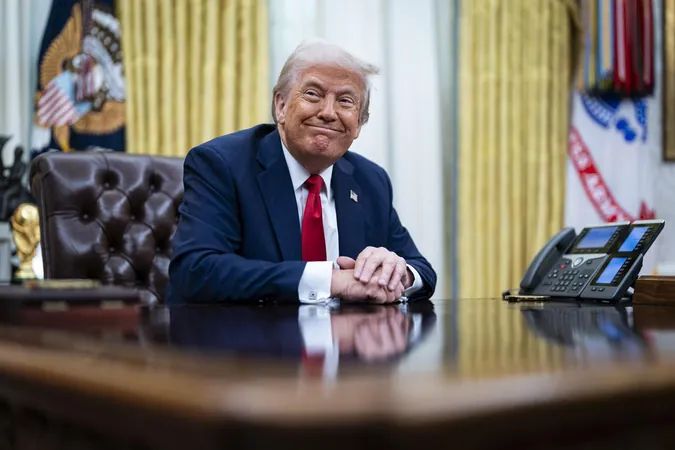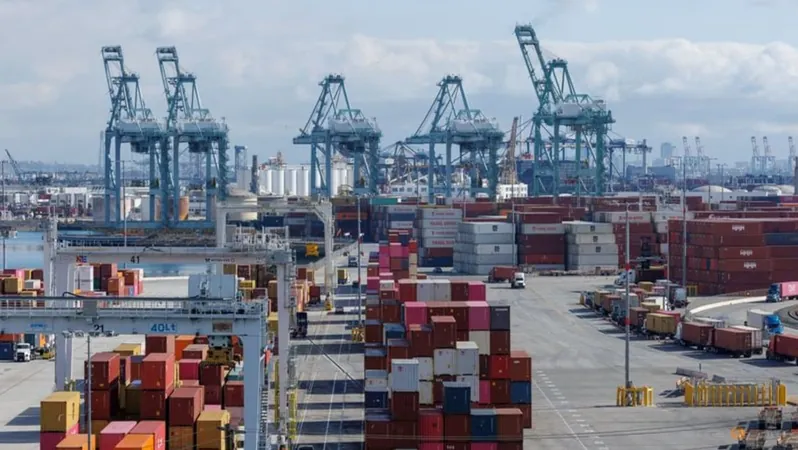
Trump's Tariff Tidal Wave: Will It Sink the Global Economy?
2025-04-01
Author: Siti
WASHINGTON - In a bold move that has sent shockwaves through global markets, White House officials announced on April 1 that President Donald Trump will impose a sweeping set of tariffs starting April 2. While the specifics remain under wraps, the looming trade barriers have sent tremors of anxiety through businesses, consumers, and investors alike, as the world braces for what could escalate into a full-blown trade war.
Dubbed “Liberation Day” by Mr. Trump, the April 2 announcement is set for 4 PM Eastern Time, where he is expected to unveil tariffs that could radically alter the landscape of international trade. White House spokeswoman Karoline Leavitt indicated that tariffs will be imposed on nations that have already enacted duties on American goods, with an eye-catching 25% tax on automobile imports taking effect on April 3.
Treasury Secretary Scott Bessent reportedly communicated to Republican lawmakers that these new tariffs represent a potential cap—the highest level of tariffs that foreign countries might encounter, contingent upon their compliance with U.S. trade expectations.
Yet, this isn't Trump’s first foray into tariffs; previously, he has targeted aluminum and steel imports and has threatened various other tariffs only to backtrack later. This time, however, Ms. Leavitt assured the press that the administration, characterized by its "brilliant team of advisors," is fully committed to the new tariff guidelines, aiming to usher in a prosperous era for American industry.
However, this strategy has raised alarm bells across different sectors. Economists from the Federal Reserve Bank of Atlanta have indicated that executives foresee substantial price increases attributed to these tariffs, which may hinder hiring and stifle growth.
While Trump’s April 2 announcement remains shrouded in uncertainty, there are speculations about a universal tariff, potentially augmenting duties by around 20% on goods imported from numerous nations. Such broad measures could result in over $6 trillion in revenue, which the administration suggests might be funneled back to American taxpayers as rebates.
Foreign responses have already begun to materialize. Canada, under Prime Minister Mark Carney, has pledged to retaliate with its own tariffs, stating unequivocally that Canadian workers will not be disadvantaged. Meanwhile, Mexican President Claudia Sheinbaum expressed solidarity with Canada as both nations prepare to resist what they deem unjustified trade actions from the U.S.
The implementation of these tariffs poses risks beyond the North American borders. In light of these developments, companies across the U.S. are already witnessing a rise in a “Buy Canadian” movement, making it progressively difficult for U.S. products to penetrate Canadian markets. Other countries are simultaneously preparing countermeasures while negotiating with the U.S. to avoid the brunt of the tariffs.
Economists have voiced concerns that Trump’s tariff-heavy strategy might inflame inflation, ultimately harming American households. A 20% tariff could possibly burden the average U.S. household by an estimated $3,400, as reported by the Yale University Budget Lab.
As uncertainty looms, there are visible signs that the U.S. economy is beginning to lose steam. Business confidence is waning, and the stock market has taken a considerable hit, shrinking by nearly $5 trillion since February due to investor apprehension surrounding Trump's unpredictability.
Global manufacturing sectors, from Japan to the U.K., have exhibited declines in activity as businesses ready themselves for the impending tariffs. The Institute for Supply Management reported a contraction in U.S. manufacturing activity, which raises the specter of potential stagflation—a situation marked by stagnant economic growth and rising prices.
As the world turns its gaze to the unfolding events on April 2, the big question remains: Will President Trump’s ambitious tariffs revitalize American manufacturing, or will they lead to economic turmoil and an escalating trade war? Only time will tell, as economic specialists warn that the ripple effects could disrupt markets far beyond U.S. borders.





 Brasil (PT)
Brasil (PT)
 Canada (EN)
Canada (EN)
 Chile (ES)
Chile (ES)
 Česko (CS)
Česko (CS)
 대한민국 (KO)
대한민국 (KO)
 España (ES)
España (ES)
 France (FR)
France (FR)
 Hong Kong (EN)
Hong Kong (EN)
 Italia (IT)
Italia (IT)
 日本 (JA)
日本 (JA)
 Magyarország (HU)
Magyarország (HU)
 Norge (NO)
Norge (NO)
 Polska (PL)
Polska (PL)
 Schweiz (DE)
Schweiz (DE)
 Singapore (EN)
Singapore (EN)
 Sverige (SV)
Sverige (SV)
 Suomi (FI)
Suomi (FI)
 Türkiye (TR)
Türkiye (TR)
 الإمارات العربية المتحدة (AR)
الإمارات العربية المتحدة (AR)